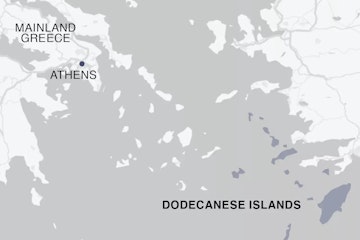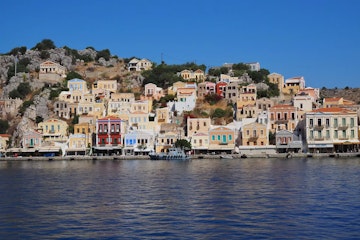The 165 or so islets of the Dodecanese chain dot the far eastern Aegean in a rough north-south line. With the mountainous silhouette of the Turkish coast on one side and Crete somewhere in the distance on the other, these are among the hottest and the most historic of the whole Greek archipelago. Among them are stand-out vacation meccas like Rhodes and Kos, where everyone from families to 18-30s partiers find something to love. But there are also more off-beat gems that are only just being discovered, such as the climbing hub of rugged Kalymnos and the scuba centre of Leros.
Our guide to Dodecanese island hopping reveals all you need to know about exploring this balmy region of sun-baked beaches and UNESCO-tagged castles. It's got tips on getting around, picking the top islands, and the best times to travel.
Where Are the Dodecanese Islands?
Dodecanese island hopping will take you just about as close to Turkey as it's possible to go without crossing the border. Yep, this chain is the easternmost in all of Greece. At some points, the shoreline of the Anatolia region of Turkey is less than three miles away (daytrip, anyone?), and you can all but see the outlines of yachts sailing in and out of the coves around Bodrum when it's clear.

When to Visit the Dodecanese Islands?
The Dodecanese Islands are blessed with some of the hottest weather in the whole country. Only nearby Crete can trump Rhodes and Kos for summertime highs, but you also find that the warm season lasts a few weeks longer in this south-eastern corner of the Aegean than elsewhere – notably the Cyclades and Ionia.
That means the autumn is just about perfect. Maximum temperatures stay well above 20 until the end of November most years, with October offering a pleasant mercury level of about 24-25 at its peak. There's also hardly a drop of rainfall until the end of September. The upshot? Look out for late-season trips to dodge the Greek summer crowds but still get great weather.
Other vacationers are bound to love the summer months, especially the most dedicated sun seekers. Mhmm…Rhodes, Kos, Symi, and Karpathos are loaded with beaches where you can cool off on the hottest days, which can exceed 40 Celsius on occasion. On top of that, June to August is when the resorts of Faliraki and Kardamaina go into overdrive with partiers (hello, hedonism!). The summer season is also the windiest of the lot, which means kite surfers get to enjoy the world-class bays of Paralia Prasonisiou on Rhodes and Gun Bay on Karpathos.

The Top Dodecanese Islands
There are more than 150 Dodecanese Islands. Most aren't even on the travel radar; little more than specks in the distant Aegean. Others are regular fodder for travel brochures and have been for decades. Here's a look at some of the best…
Rhodes
Rhodes is one of those islands that you won't forget. Ever. The main town, where most of the ferries get in, is a mass of castles that jumble and jostle over one another, hiding crooked, cobbled streets once trodden by the Hospitaller Knights and Crusaders. The whole place is a UNESCO World Heritage Site, replete with medieval barracks and hospitals. Spend some time there, for sure, but don't be distracted too much. The rest of the island stretches west into the Aegean, complete with gorgeous beaches like Lindos and Anthony Quinn.

Karpathos
Unlike the other Dodecanese islands that straddle the edge of Turkey, Karpathos brings us back westwards into the depths of the south Aegean. Crete is the next island over, and the bath-warm swathes of the Libyan Sea take over on one coast. The geography means that Karpathos is a touch different to its neighbours. For one, it's wild at heart, with a spine of high mountains that host villages that are often above the clouds. Come here to kitesurf in one of Europe's most acclaimed bays, see mystical caves where the Titans were born, and explore pint-sized villages like Olymbos that have been stuck in time for decades.
Symi
The old sailor mansions of Symi huddle in the island's main port like beads of glimmering mountain honey, glinting yellow and ochre against the sky-blue tints of the Med. They herald one of the most handsome towns in Greece; a place that channels a touch of the Italian Riviera and comes brimming with excellent tavernas selling fish straight off the boats. Most come on a day trip out of Rhodes, but we'd say linger a little. The pace is slow, the beaches are wonderful, and there's R&R around every corner.

Astypalea
Astypalea bridges the gap between the popular Cyclades islands and the eastern Aegean. For that reason, it's often a good choice for yachters planning Dodecanese island hopping adventures that start on Santorini or Mykonos. The isle itself is shaped like the spread wings of a butterfly. The highlight has to be the main town. It's a shock of whitewashed cottages that jostle with each other on a peak that's crowned by a formidable Venetian castle.
Kos
If it's soft, powdery beaches and salt-washed Greek tavernas, lux hotels on the shoreline and clear Aegean snorkelling spots you want, you could do a whole load worse than Kos. The south coast here is a steady stream of surely some of the best beaches in eastern Greece – from family-fun Kardamaina to the rock-topped Agios Stefanos. Kos also enchants inland, where the Dikeos Mountains creep skyward to hide towns like Zia amid forests of pine and eucalyptus.

The Top Things to See and Do in the Dodecanese Islands
What we love about Dodecanese island hopping is that there's something for all sorts of travellers. From enthralling history sites to glimmering beaches to handsome harbour towns, there's plenty on offer in these parts…
The Medieval City of Rhodes, Rhodes
Arguably the great UNESCO site of Greece outside of Athens, the Medieval City of Rhodes is a lived-in quarter of the island's capital. However, it has a history that spans over 1,000 years, piling on Byzantine, medieval, Ottoman, and Gothic architecture. The piece de resistance is the Palace of the Grand Master. It's a 14th-century fort that was once a bastion of European Christendom. That said, simply wandering around and getting lost in the side streets and alleys is a joy in itself.

Basically Everywhere, Leros
When it's time to escape the buzz of Rhodes town or the party streets of Faliraki, we can't think of any better member of the Dodecanese chain than Leros. This small dot on the map at the north end of the region still rolls to a very rustic beat. You can drop into little Agia Marina, a town of charming mansions that fronts a big bay laden with snorkelling spots. You can scale the great Castle of Panagia for sweeping views of the island. Oh, and you can enjoy some of the top scuba diving in Greece, thanks to uber-clear surrounding waters that have visibility levels of 25+ metres.
Symi Harbour, Symi
We could wax lyrical about the beauty of Symi Harbour until the Aegean Sea dried up (which, we hope, is never!). Wedged into a small inlet that faces the Turkish coast, it's a bijou collection of pastel-tinged buildings that roll all the way to a marina filled with yachts and fishing skiffs and tavernas. A few ubiquitous windmills crown the top of the hill, and so do the ruins of the medieval castle. Be sure to have the camera charged for your arrival – it's gorgeous!

Lindos, Rhodes
It's hard to picture a place that sums up the Dodecanese chain more than Lindos. The town looks tailor-made for the travel brochures. Layer one: The Lindos Acropolis, a clutch of ancient temples and colonnades. Layer two: A halo of brilliant white buildings with flat-topped roofs, all woven together by squiggling streets brimming with olive oil shops and tavernas. Layer three: The beach, a sweeping run of beige sand with olive trees and pines just behind. What more could you want?
Thermes Beach, Kos
You're sure to be wowed by the quality of the beaches pretty much anywhere you go on Kos. However, Thermes Beach is a little more than just perfect white pebbles and see-through seas. It has another trick up its sleeve: Thermal springs. Yep, notice how the locals come to bob around in the rock pools for hours on end, even in December! The H2O is warmed by natural underground vents that keep it a steady 30-40 degrees.

How to Get to the Dodecanese Islands
There are two main aviation hubs that serve the Dodecanese region. Most travellers opt to jet straight into one of them and then use onward ferries or a yacht charter of their own to get around.
The busiest arrival point is at the Rhodes Diagoras International Airport (RHO). It serves about 1.5 million passengers each year and almost solely hosts seasonal flights that go throughout Europe, although there are also domestic links to Athens with Aegean Airlines that run all year round. You can also fly into the Kos International Airport (KGS). That's smaller but still well served by popular flag-carrying and low-cost airlines like TUI, Wizz, LOT Polish, easyJet, and Jet2.com.
It's also possible to sail to the Dodecanese. There are ferries to the main port on Rhodes from the capital's port of Piraeus several times each week between spring and autumn. They take around 12.5 hours in all and usually go overnight, so you should book a ticket with a berth unless you fancy sleeping on deck. Those connections also usually stop at popular Cyclades islands along the way, meaning you can hop onboard and travel east from Mykonos, Santorini, Ios – the list goes on.
Finally, the Dodecanese are pretty unique because they are just a hair's breadth away from many busy Turkish ports. Summertime links that take as little as 45 minutes can get you into Kos from Bodrum, while other connections link Bodrum to Rhodes and – occasionally, though this changes every year – Symi.

Getting Between the Dodecanese Islands
Naturally, having access to your own boat is the holy grail of Dodecanese island hopping. However, this chain is one of the best-connected of the bunch for those who like to go from A to B and never back on themselves only using public ferries.
We'd recommend choosing one of the two big islands – that's Kos or Rhodes – to start out. They have links to pretty much all of the smaller Dodecanese. Generally speaking, Rhodes will be a better starting point for the southern part of the chain (Symi, Karpathos, Tilos), while Kos is better for the northern isles (Kalymnos, Leros).
You should find that there's a good array of onward boat links on offer from each of the lesser-known destinations. For example, boats go from Kalymnos to Leros, from Tilos to Nisiros, from Patmos to Lipsi, all without having to dock back up at a major port. That said, most of the secondary island connections only run in the peak season, so you could be limited to Dodecanese island hopping trips between May and August.

This guide to Dodecanese island hopping is all about showcasing the charms and wonders of Greece's easternmost islands, sat just on the cusp of the Turkish Turquoise Coast. Be sure to get in touch for more inspiration on island hopping adventures in this incredible part of the world.


